#ITS JUST. its not very obvious.
Explore tagged Tumblr posts
Text
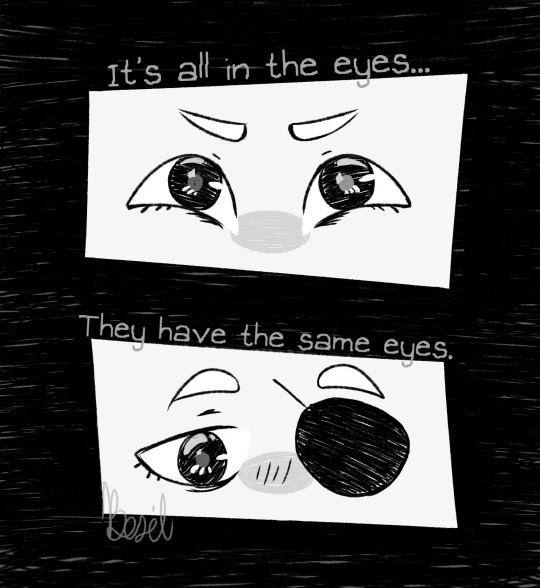
hey man. have i ever. have i ever talked about how often i think about isabeau recognizing loop from their eyes.
'yes basil.' you tell me. 'youve actually written about it like five times now.'
anyways heres another.
#in stars and time#in stars and time spoilers#isat#isat spoilers#isat fanart#in stars and time fanart#loop isat#siffrin isat#isat act 6 spoilers#isaloops au#BECAUSE THIS IS. THIS IS ISALOOPS STUFF IT IS A LINE DIRECTLY FROM ONE OF THE THINGS IVE WRITTEN AND POSTED#ITS JUST. its not very obvious.#but hrgfgghgh..... URGHGHGH...#rotating them in my mind. them and sif both. together and separate. always always always#basil paints#anyways its like midnight i should NOT be posting rn but shhhhhh#of stitches in sequence
605 notes
·
View notes
Text

would you bite the hand that feeds you?
#pearlescentmoon#smajor1995#wild life smp#namemc spoilers#i hope these two never get along in the storyline i find them fascinating#OKAY SO#originally i had this sketch back in session 2 when scott manages to throw her something actually edible JUST IN TIME#and now with the namemc spoilers of pearl ACTUALLY having a yellow eye which does! kind of match scotts esp since he died for this#i figured itd be an appropriate time#i did edit it though the original was pearl eating smth#now do i think scott and pearl has had any Major (heh) interactions to warrant this fanart in WL?#frankly no LMAO theyve been very civil you go guys . but i like the dynamics between them anyway#also i finally got a piece with scott!!! hes been very hard to draw goodness#anyway long rambly tags#eydidraws#my art#mcyt#trafficblr#galaxyduo#majormoon#** i say civil because its just been more on verbal light jabs at each other rather than anything Really significant ?#and well. its obvious all 3Gs are being very careful around each other which makes me JUST A L IL SAD#id love to see them let loose and be vicious but i also understand the angle theyre coming from#anyway can you tell i like the 3g dynamics
6K notes
·
View notes
Text
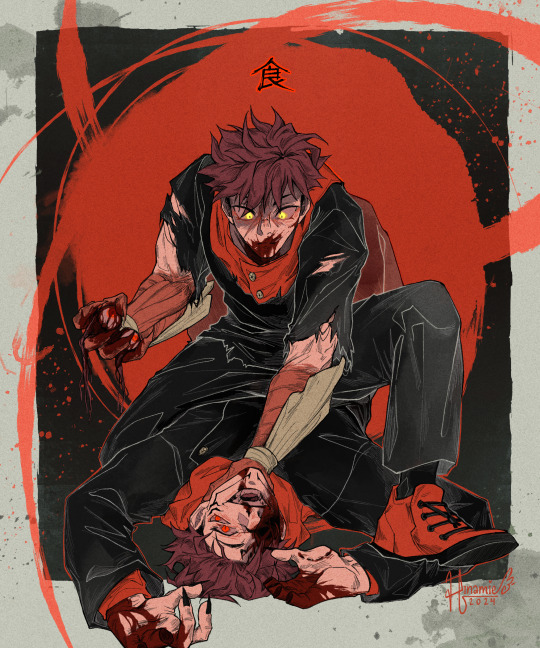
I'll rip in hands and teeth and take a bite
#my art#jujutsu kaisen#jjk#yuji itadori#ryomen sukuna#yuuji#sukuna#sukuita#fanart#jjk fanart#gore tw/#body horror tw/#blood tw/#YUUJIIII BABY BOYYYY BABYYYYYY#hes hungry :/#sukuna seems 2 be having fun gdjhfgsdf . boys when theyre bored.#so happy i wrangled this pose in2 something im happy with i almost abandoned the idea entirely#sometimes front facing is the answer.....who knew :'>#also#can anyone tell me. how far up yuujis fun arms go i had no idea so i just stopped them at the elbow#if im wrong that will b not swaggy :(#listening 2 sena's cover of butchers vanity on repeat btw VIBES#cannibalism motifs my beloved uwu#in other news this is the least amount of shading ive done in a very long time#and its been even longer since i pulled out th white lineart#but overall i like this piece so much yuuji is so cute and it doesnt make sense 2 me at all#edit changed the colour to make it more obvious whats sukunas legs vs whats yuujis back
15K notes
·
View notes
Text
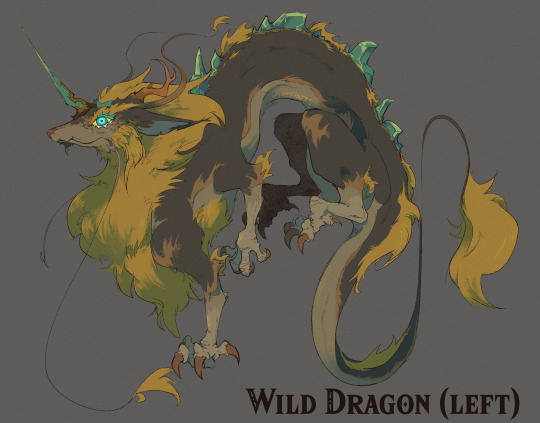
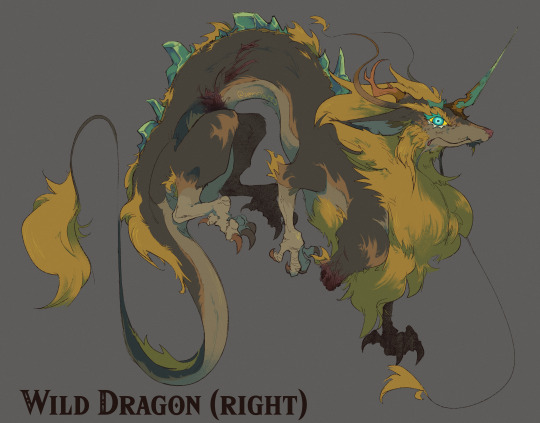
(click for higher quality!) draconified link concept ive been chipping away at this past week ..... here's my funny little compendium concept for him:
"A heroic spirit has taken the form of this bestial dragon. Unlike it's kin, this creature exhibits an extremely aggressive disposition. It appears highly territorial, and will relentlessly chase down those who disturb its skywide patrols - of which it seems to be endlessly searching for either a long-time vassal or foe. Unfortunately, it seems the spirit within has long since forgotten exactly who it was looking for…"
#now. how on earth do i begin to tag this. um.#link#loz#totk#totk spoilers#light dragon#dragon link#loz au#totk roleswap au#there . i'll add more if they come to me LOL#um i can talk about some of my insps i guess?? might make another post too#so mostly i just dont really like turning him into 'light dragon but male' and giving him slightly darker colours or something like that#this also obviously isnt exactly like the botw dragons either though and its a bit more of a mix of other creature concepts i enjoy#since everyone agrees he'd have a farosh horn i wanted to make him a kirin/unicorn :) which is why his tail looks like that#aside from the obvious eastern dragon insps and what ive picked and chosen from the botw dragons#and obviously this looks a lot like wolf link. thats on purpose#i wanted to give him some fierce deity design refs too but because this is so dark/earthy they didnt look very fitting#but honestly you could do a whole fierce deity dragon design on its own i think#okay lots of tags but IVE THOUGHT ABOUT THIS FOR A WHILE. okay. let me have this.#my art#dragon link au
5K notes
·
View notes
Text
I think if you consider yourself someone who genuinely cares about dismantling bioessentalism and the speaking out about harm it does to society you HAVE to acknowledge that bioessentalism is one of the oldest tools in the patriarchy's toolbox and not something twentieth-century TERFs invented
#this is not to say bioessentalism is NOT relevant to discussions of terfism btw#I just see too many people speaking about bioessentalist rhetoric as if its something only TERFs or Bad Women utilize#and that is fundamentally incorrect lol#I think acknowledging that bioessentalism has always been a tool of the patriarchy is important esp when talking about the very obvious#connections between terfism and 'traditional' right wing ideology#idk I think a lot of people just talk about bioessentalism as something Women(TM) believe and its really weird to me
2K notes
·
View notes
Text
There are two things that Damian knows that he knows Father doesn’t.
He has an older brother
He was dead
(And a secret third thing: Damian was glad he was dead. They did not get along.)
Well. No, correction, they were two things that Damian knew that Father didn't. Past tense. Strange magic swirled through the air and created a mirage before his eyes, and immediately a scowl forms across his face.
The mirage shifts and shimmers like the light hitting a slowly turning prism, and then it settles into a memory. One that Damian does not recall. Like looking into a tv screen, it shows, faintly, a room, with most of the magic going into the image of a crib.
His mother was standing on one side, and next to her, standing on his tiptoes was a small five year old boy looking up at her. With dark hair and skin that was only few shades lighter brown than Damian's, the little boy's resemblance to Damian was undeniable.
However, his eyes were blue. Not green. Damian's scowl deepens, and he sinks back. "Danyal." He mutters, and feels eyes turn on to him.
Danyal Al Ghul. Damian's older brother. A prodigal swordsman like Damian, and five years his senior. He'd be fifteen if he was still alive. His memory of the last time he saw his brother was still clear in his mind.
(A sword to Danyal's neck. Stars were glittering through his window. Damian was five, Danyal ten. He is not sure why Danyal had snuck into his room, all he remembers is hearing a sound and on instinct reaching for his sword.)
(His brother had intercepted easily. But had not shoved the sword away. Moonlight hit his blue eyes, and Damian remembers seeing the pupils shrink to let the light in. His eyes looked almost silver.)
(His brother bares his teeth at him. Damian wants to slice his neck more than anything, and he bares his teeth back. "Good." Danyal says, his voice low in a hiss, "Your reflexes are good, little brother.")
("Of course they are," Damian remembers snarling, and presses the sword closer. But it does not budge. "I am an Al Ghul.")
(Something unrecognizable passes through his brother's eyes, and his mouth twists into something like a smile. "I know." He says, and tilts his head downwards at him. "And you will be great.")
(His brother shoves the sword back, causing Damian to stumble. And like the wind, he is gone.)
(The next morning, he goes on a mission with mother and a few others. Mother is the only one to return with Danyal's sword, and a red-eyed look in her eyes. Damian does not mourn. Now there's only one of them.)
"Momma." The little Danyal-mirage speaks, a furrow between his childlike brows as mother lowers a bundle into the crib. His blue eyes watch her, and lifts onto his toes to peer into the crib as she sets the baby down. "Who is this?"
Their mother's hand comes to rest along his back. "This is Damian, my son." She murmurs, voice low. "He is your little brother. Protect him well."
Damian scoffs internally -- not likely. He remembers every spar he ever had with Danyal, every harsh word and insult. His pushing, pushing, pushing for Damian to get up. To try again. Do it again. The only kindness he ever showed him was when his fingers bled. And even that was harsh, firm. Rolling gauze around his wrist and scolding him, telling him how to wield his weapon better.
(It was the same as everyone else, but somehow it hurt worse coming from his own brother.)
But he watches his older brother's youngest self tilt his head to the side, and then reach his chubby hand through the crib's bars. He runs small, blunt fingers over the baby's arm, and the baby jerks. Through the crib's bars, Damian sees himself grab Danyal's fingers.
And he scowls even deeper.
And Danyal's eyes... widen. He lets out a little gasp, and a small smile Damian's never seen him wear tilts at the corner of his mouth as he looks up at their mother. "Mother," he whispers, "he grabbed me!"
Damian... his scowl falters, for a moment.
He doesn't wait for a response, he looks back to the baby with sparking eyes. His expression melts like sugar as he bounces the finger being gripped tight by the small hand. "Hello, little brother." His brother says, voice its of usual firmness, but there's more fondness underlying it than Damian's ever heard. "My name is Danyal."
The mirage shifts before Damian can comprehend his older brother's voice. It shows the crib again, appearing as if a few days had passed. There is night lilting through the nearby window, and a creek of the door. The baby doesn't stir.
Danyal sneaks in, still wearing his training clothes and a sword strapped to his side. Damian's scowl returns, watching him creep over to the crib. Of course -- the last night he saw his brother wasn't the only time he'd snuck into his room.
Would he go so low as to attack an infant? Damian wonders, watching his brother cross the room to his crib. But while his fingers rest against the hilt, they never curl to unsheathe.
His brother peers into the crib again, and there it is again, that smile wider in the corner of his mouth. It's not a full one, but its as uninhibited as it gets. Dripping honey-sweet with awe. "You are so tiny." Danyal whispers, and pokes a finger back through the crib. It wriggles, then pokes Damian's cheek gently. "Was I as small as you when mother gave birth to me?"
There is no response from the baby. Not a coherent one anyways, the little thing snuffles and turns his head, mouth open to latch. Danyal stills, his eyes grow ever wider again.
Danyal says nothing else, just rests his cheek against the crib and watches the baby sleep in silence. The affection never leaves his young face.
Damian feels unsettled. Off-foot. This Danyal is foreign to him... He wonders what happened to have changed his brother's mind on him.
There's a scuffle, quiet, but there. Danyal picks up on it just as Damian does, and his head pricks up like a deer, head already turning away from the crib. The affection leaves his face, falling away like water into something serious. His blade is already slightly unsheathed.
Two assassins, belonging to grandfather, burst out of the shadows. Their swords swinging into the air and ready to strike.
Danyal kills them both, his back to the crib. It's not without struggle, and when the two assassins lay dead on the floor, the baby is wailing at the top of his lungs. Danyal has a laceration cleaving down diagonal of his cheek. It's close to his eye, just barely missed blinding him.
Damian never knew how he got that scar. He does now. (He doesn't know how to feel about it.)
His brother clutches his bleeding face, sheathing his sword as tears well up onto his face. But he turns towards the crib, and hurries over. "You're okay, you're okay, you're okay." He hushes rapidly, the League-drilled seriousness fallen away to reveal a panic-stricken five year old. He sticks one hand into the crib, the one not clutching anything, and grabs little Damian's hand.
Their mother comes bursting in that moment, and Danyal turns his head towards her. "Mother." He says, his voice cracks un-wantingly. Their mother steps over the bodies of the assassins easily. "They tried to kill Damian."
"But they did not." Talias says, kneeling down next to the crib to inspect Danyal's face and Damian's well-being. When she finds nothing of concern beyond the injury, she continues. "You killed them before they could, Danyal. Well done."
The mirage of his brother nods, his eyes teary and red.
Damian... is discomfited. he never thought Danyal would kill assassins for him. He would have thought his brother would sooner look the other way. The mirage shifts again, and it quickly shows time passing.
Danyal sits in Damian's nursery every night, after that. He lays at the foot of the crib with his sword, a pillow and a blanket with him. Some nights there is nothing but peace -- or as close to peace as a baby could achieve -- and some days assassins break in.
Danyal kills each one.
The mirage shifts again, and it shows more memories of Danyal interacting with Damian during his youth too young for him to remember. His first steps, his first words.
"Danya." The small toddler of Damian says, arms reaching for Danyal.
A frown curls across Danyal's face, and pulls Damian into his lap. "No, no, little brother." He scolds, voice firm but.. softer. "It is Danyal, Damian. Danyal."
"Danya!"
Damian's brother sighs, but there is that same-small tilt at the corner of his mouth. A glimmer in his eyes. A glimmer... that Damian is finding he recognizes.
(He always thought his brother got that look in his eyes when he was mocking him. Was he wrong?)
The mirage shifts again, and this time it shows only mother and Danyal, alone. Danyal is older, taller. Seven, if Damian had to guess. Mother has a stern look on her face, her hands tight on his shoulders. "Damian will be starting training soon, my son."
Ah, then close to eight then. Training starts, always, at three years old. He watches Danyal nod, his expression mimicking their mother's. His arms are folded, always folded, behind his back, always neat.
"You can no longer have the relationship with your brother as you did before." Mother says.
Danyal's expression... falters. It shifts, it fluctuates. He looks surprised, thrown off. Like he isn't quite sure he heard what mother just said. His brows furrow. "What... do you mean, mother?"
"I mean what I said, Danyal." Mother says, stern, "Ra's will be keeping a closer eye on Damian now that he is of age to begin his training. He will not like if he sees you both getting along."
"I am sorry, my child. But your relationship with Damian ends here. You are rivals now, not brothers." In a cruel form a gentleness, mother raises her hand and tucks a stray curl out of Danyal's face.
Of course. Damian never had a relationship with his brother because of Grandfather. Of course. No, he's not feeling a little bitter. No. There's not an inner child that still, like a candleflame, wishes that he'd had a bond with his only flesh and blood.
Danyal is dead now. So it's not like it matters. He's happy about this.
Danyal frowns, and he steps back. He looks lost in thought. "We are still brothers, mother," he says, argues, and looks up to meet mother's eyes. "Let me train him, I will make sure he gets the skill he needs. If we must be rivals, then I will teach him how to defeat me. If he can defeat me, he can defeat anybody."
Their mother, and Damian, both blink in unison. Then mother smiles something sharp, calculated. She folds her hands behind her back. "Then do it. But you will make him hate you."
"...So be it."
Damian.... Damian is silent. His world axis has been tilted on its head. He is sliding, and sliding, and sliding down. Spinning. Many things click into place at once.
More memories from the mirage show. It shows Danyal training Damian. It shows their arguing, their bickering. It shows Danyal going to their mother to praise Damian and his skills, how fast he is picking up on the sword. How one day he will surpass even him.
It shows Danyal sitting outside Damian's bedroom door every night, listening in for anyone who dares to break in. His knees drawn to his chest, his sword at his side. Sometimes he sneaks in, sword drawn, when he hears a sound.
Some nights, Damian wakes up. He remembers those nights. Danyal standing over his bed with his sword unsheathed and tight at his side. He remembers the instant terror as he immediately reached for his own weapon.
His brother always scolded him for his lack of vigilance. That had he been anyone else, Damian would have had his neck cut. He would've been dead already. It only made Damian's hatred of him grow.
But he understands now. Because there were assassins in the room that Damian, four years old, three, did not notice. Not until later. He always assumed the attacks on him after Danyal's death had been because now there was a new heir to target.
It had been the only lesson he'd been even somewhat grateful for.
Then finally the mirage shimmers, and it shows Danyal, ten years old, in one of the training rooms, mid-spar with Mother. It's fast, sharp, impressive and like a blur. Damian is unsure if at ten which one of them was the better swordsman. Some of the assassins who have never met Danyal said Damian was, but the ones who had said it was Danyal. He'll never know.
In a lull in the fight, when their swords are crossed, mother speaks. "Ra's wants you and Damian to fight." She says, teeth grit into a deep scowl. The cross breaks and Danyal jumps back, he frowns.
"We have fought, mother." He says, and dives in first, swinging for mother's feet. Mother dodges, and slices at his arm. He swerves out of the way, twisting on his feet like a dance. "We are always fighting, doesn't he see our spars?"
"Not a spar like that, my son." Mother says, a snarl in her voice. She lunges, and Danyal blocks her blade. "A fight to the death. Father has grown tired of having two heirs."
That gets Danyal's attention -- or, more accurately, it distracts it. His eyes widen, and his sword lowers for a single moment. A mistake. "What?" Is all he gets out before mother has him on his back, her blade pressed to his throat.
He freezes. As does Damian. Danyal's brows furrow, then unfurrow, only to knot up again. "Mother, what do you mean a fight to the death?" He flips to his feet when mother removes the sword. She walks over to grab her water.
"Must I repeat myself, Danyal?" Mother snaps, rubbing her forehead before swigging from her canteen. "Father wants to find out which one of you is the stronger heir, and so you will fight to the death after your training in a few days."
Danyal's tan face loses a shade of color, he looks ashy. "There must be some mistake!" He exclaims, his arms gesturing out as he peers around mother. "There is a five year disparity between us, Damian has only just started training two years ago. It would be an unfair fight!"
"Do you think me unaware?" Mother whirls on him, and there is a grief-stricken look on her face. Like she is already mourning Damian's death. Damian feels ill. "Your skill is far beyond what Damian can accomplish right now, and there is nothing that I say that can convince Father otherwise."
Danyal wears an expression like he is scrambling for answers. A white knuckle grip on his weapon. There is a long silence, and his lower lip curls up. His throat bobs, he swallows. "Is there really nothing we can do?"
Mother makes a frustrated sound, pushing her loose hairs out of her face. "Not unless Father changes his mind, or I send one of you away. But Father would surely send someone to look for you or Damian."
"What if one of us faked our death?"
Mother stills. As does Damian. No, he thinks, stiff as a rod, no way. These mirages were lying, nothing but figments of an imagination. Of some quiet what-if that Damian had not yet stomped out.
Mother's expression shifts, and then turns contemplative. Danyal notices, and keeps pushing, he looks as hopeful as he could get beyond his usual unwavering, stone-like expression. "One of us could go to father--"
"No." Mother cuts off, voice sharp. Danyal wilts, confusion flittering across his face. Damian, from the corner of his eye, sees Father tense as stone. His white-slit eyes have not left the mirage. Nobody's has.
"Father will undoubtedly check there first, it would not be a good idea. You or Damian will have to go somewhere where he would not think to look. Someone unaffiliated with the League."
Danyal's face falls, shutters, and then closes up again into stone. Mother begins to pace, and Danyal's blue eyes follow her. "So a stranger?" He asks, and there is disgust lilting into his voice.
Mother nods, and she looks just as offput as Danyal.
The mirage of Damian's brother rolls his shoulders back. "Then I will do it, mother." He says, voice unwavering. There is a stubborn note behind it all, one that Damian recognizes. "I will fake my death, and Damian will stay here."
Mother's eyes turn sharp on him, and she stops in her spot. She pivots. "Are you sure?" She asks, eyebrow raising, "There is a chance you will never meet your Father if you leave. Nor will you see I or Damian again, if you do this."
Something like fear flickers across Danyal's face, eyes widening momentarily -- as if that very thought had not crossed his mind. But then it smooths over to sharp determination. He nods. "It would be the same for Damian if it was him instead. I will do it, Mother."
Damian feels ill again. Father has a strong set in his jaw, his teeth grinding.
Mother stares at Danyal, and then her expression softens. And like before, it is grieving. "In a few days time, I and another member of the League will be going on a mission to the American States. I will tell Father that you will accompany me, once there we will dispose of the other member and then orchestrate your death."
The American States. Danyal was here, in the country. He was out there somewhere -- but no this was fake. It had to be. Danyal was dead. A fool who got himself killed on a mission with mother and left the title of Heir to Damian.
Or maybe it had been his plan all along. His and mother's both.
...Was mother ever going to tell him?
The mirage of Danyal nods, sharp. Understanding. There is a gleam in his eyes that is not pride, it is tears. And when Mother leaves the room and leaves him alone, the stone-like expression on his face crumbles and falls.
His brother, ten years old, curls up his lip in an ugly way. It wobbles as the tears in his eyes do, and he brings up his hand to slam it over his mouth. And sinks to his knees, a yell-like sob muffled behind the skin.
His brother, ten years old, looks smaller than Damian remembers him being, and cries.
Damian has never seen Danyal cry. Not once in the mirage of memories, nor in his own.
The memory holds for a minute, and then disappears. And no new one shows up. The magic is gone, and it leaves a silence in its wake. Heavy, staticky, and full of revelations.
So there are two things that Damian knows that his Father now knows too.
He has an older brother
His older brother is alive.
(And a new secret third thing: Damian wasn't sure how to feel about it.)
#dpxdc#dp x dc#dp x dc crossover#danny fenton is not the ghost king#dp x dc prompt#dpxdc prompt#i promise this is a prompt#it just got very long#danyal al ghul au#my take on a danyal al ghul au#older brother danny#dpdc#dpxdc crossover#i know the usual gist is that danyal al ghul is a better knife thrower than he is a swordsman but hey#consider: phantom has a sword when he fights ghosts. how sick is that?#his ghost form having allusions to the LoA. its not obvious but its there#did i make danny brown skinned? yeah. because him being white or not is irrelevant to me and i wanted to make him darker skinned#thinking about the angst of bruce seeing his firstborn son going “i could stay with father!” and then said child being visibly crushed#when told no. and that he may never see his father ever. actually. if he fakes his death. and still doing it anyways for damian's sake#danny loves his little brother he just shows it in an unorthodox way. some of it is not his fault#also danny being an absolute grump in amity park is very funny to me. he's an arrogant little assassin child in AP who is only here for#his little brother's sake and safety. he loves his brother but that doesnt stop him from being an arrogant little brat#gremlin assassin child danny is so funny#i know this is very ironic for me to post after posting my thoughts on danyal al ghul aus and their missed potential#but actually this prompt is what spurred that post into creation in the first place actually.#because i was thinking about this au and then went “oh hey you know whats funny--” and then i#thought about it too much to the point where i had to make a post talking about it#tried to find a balance between danny being mature for his age and also still being a kid#like yeah he’s a trained assassin and has killed but also he’s a 10yo boy about to be separated - Assumingly permanently- from his family
3K notes
·
View notes
Text


@magicicephoenix NOW THEY ARE !!!
#i wanted to post this on its own cuz this is really cute#they both get very very flustered at hand holding as i said earlier. sun is just simply better at hiding it when it comes to moon#moon however. moon hates being seen flustered. so he hides his face and makes it More Obvious#xandraws#food for thought au#fnaf#fnaf sb#fnaf security breach#security breach#fnaf sun#sun fnaf#fnaf moon#moon fnaf#dca sun#sun dca#dca moon#moon dca#sun x moon#moon x sun#fnaf sun x moon#dca au#dca fandom#fnaf au#dca y/n
497 notes
·
View notes
Text

Various robots/spaceships/spaceship iterations inside drone bodies/sentient viruses
#am I making it obvious that I love drawing ART#I hope I’m not making it obvious#my art#murderbot#the murderbot diaries#I neeeed to polish up my designs for the other human characters too#I think I’ve drawn most of the characters at this point LOL they’re just in my sketchbook#and my sketches 💔 are very rough#I knowww I didn’t give ART-drone enough limbs but sssshhhhhhh#pretend they’re….retractable or something#I was trying to keep its design pretty simple
507 notes
·
View notes
Text
I randomly got dragged to Mormon church and met the illustrator for A Series of Unfortunate Events who is apparently a bishop at the church, and now we are Instagram mutuals. today was so bizarre
#dw im not converting to mormonism#the Mormon missionary that asked me to go was also a native American girl & if u know about this history between natives and mormons....uhhh#one of the priests also gave this bizarre speech about how illogical the book of mormon was and how joseph smith makes 0 sense#but he was like “but its supposed to be confusing so i still believe in this religion” ???#they were all super duper nice too but kind of in the customer service way. a mormon girl also complimented my friend's lesbian jewelry#lesbian jewlery as in it was literally two female symbols linked together#it was VERY obvious and we asked the girl why she liked it and she was like. “uhh i just like jewlery hehe!!!”
650 notes
·
View notes
Text
[jigsaw voice] hello non-transfem lesbian hornyposter. before you is a computer logged into tumblr dot com. your task is to write a hornypost about a transfem lesbian without making her an aggressive dom-top or a sexual predator. should you fail in this task, the computer will explode into a pile of hammers, killing you instantly. you have 30 minutes.
#spinning my web#anyways im j tired of only ever seeing us represented as dom-tops#like. speaking as a switch/verse transfem.#i love domming and topping but it is literally ALL you TME lesbians post about us.#like its a very obvious pattern and you arent as progressive as you think you are for it#we're more than just dykes with dicks to breed you on command yknow.#anyways idk if i got the format for this right ive never seen saw.#anyways tme lesbians stop being chasers challenge impossible
908 notes
·
View notes
Text
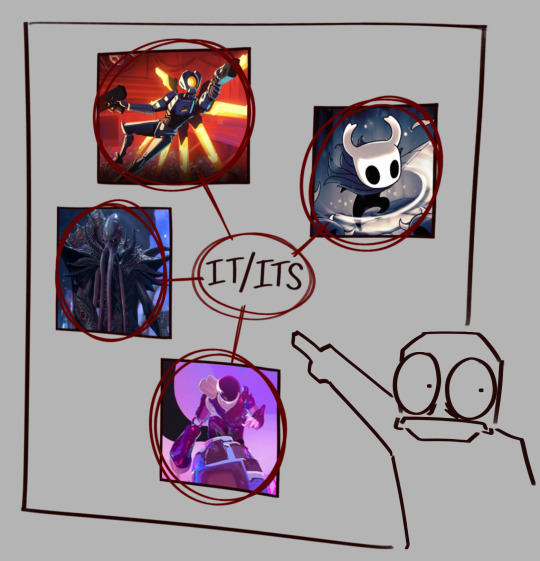
i feel like i'm fighting for my fucking life here
#ultrakill#hollow knight#risk of rain 2#baldur's gate 3#there are absolutely more out there these are just the primary ones from games *i* play#it's totally fine to hc other pronouns tho like it's very obvious when it's just queer ppl having fun#i'm talking abt the ppl who default to he/him pronouns when referring to nonhuman characters#it's always he/him too . like what's up with that#i am an any pronouns user but it/its are my favourites#and i dunno Feelsweird when it/its is pretty adamantly used for characters ingame and ppl just throw it aside#'oh but it/its pronouns are dehumanising' that's the POINT !!!!! grrr#i like it/its because it makes me feel LESS human . i connect with these characters because they are inhuman and monstrous fundamentally#. you know#this is all in good fun btw i'm not that serious about this#just felt like it needed to be pointed out
1K notes
·
View notes
Text

theyre soft your honour
#my art#jujutsu kaisen#jjk#okkotsu yuuta#inumaki toge#inuokko#inumaki#yuuta#fanart#jjk fanart#timelapse#long time no canon fits !!!#still having the time of my life playing with these brushes#i was just gna do a regular draws to slap on the ask i just got but i decided 2 record it last minute fgdgd#didnt know if an mp4 file would cooperate if i tried to put it under an ask so i played it safe#but know this is fr u anon <3#i ..... cannot believe i am continuing my streak from last night of Forgetting very key and very obvious design elements#last night it was yuuij's sukuna scars.... today it is inumaki's tattoos.......#smh im Slipping fr#breaking news tumblr user hinamie fake jjk fan And fake fanartist :C#its ok tho ! crisis averted!! me forgetting them may be caught in 4k but i Did catch myself before posting th video#that would have been tragic i would have been chased out of this fandom with pitchforks. i wld have been pelted with rocks#anyway i like this piece a lot i like them i like the black/white/blue#VERY happy i got yuuta's hair right without too much hassel#turns out i know how to draw and references r a godsend <3#oh also !!! @ the person who asked about my colouring process this is what i was talking abt re: painting with an underpaint layer#helps everything look cohesive :3
2K notes
·
View notes
Text

There's something so wondrously momentous about Style only saying his "I love you" now, when he realises that all the secrets he was keeping from Fadel are already laid bare.
He says this a significant time after Fadel has said his (and, in the context of the wider narrative, after Kant and Bison) and for the character we have seen as prone to glibness, exaggeration and flippancy with his words, that feels incredibly intentional.
Because this confession was the only truth Style had left to give.

Fadel is finally done playing his (poorly thought out) game, done with his (already cracking at the seams) charade, done with giving Style more opportunities to pull at his heartstrings with his earnestness lies.
Fadel is demanding the truth, and tells Style exactly what truth he wants to hear.

And the thing is, there is truth in this: Style's motivations at the start were wrapped up in a deception specifically targeting Fadel.
I know we, as a fandom, harp on about Style "doing all that for a car", but something I would like us all to revisit is what Kant actually says to Style when he first asks Style to "hit on" Fadel:

Kant: You need to help me. You know I don't usually feel this way about someone. And then shortly later, after Style refuses: Kant: Hey, hold on. (Kant grabs Style's hand.) What do I have to do to for you to help me out? Should I pay you?
(Please forgive my inability to gif and watch Style's reaction to this.) Style is visibly surprised and intrigued. Kant seems to be serious about this request, and I think Style decides to test just how important it is to Kant by asking for the one thing he knows Kant will not give up.



Just look the expressions on Style's face. We didn't have the context of knowing Style back then as well as we do now, but this is the look Style gets when he's throwing out a challenge (to Fadel), when he's trying to ferret out some new insight (from Fadel), when he wants to see how someone (Fadel) will react to whatever outlandish (provocative) thing he's said or done.


And when Kant agrees, Style even checks again if Kant is serious about going through with it -- and it's this that convinces Style of the sincerity of Kant's request.

Yes, the car was a factor, and yes Style also wanted revenge and to humble Fadel, but at the centre of Style's motivation has always been a plea for help from a friend.


In episode 1: Kant: Under one condition. You have to make him head over heels in love with you. Style: I'll do it. Not just for the car, but someone like him needs to be humbled by someone like me.
But in agreeing to help Kant, Style really was damning Fadel to play the fool because Fadel's feelings (his heart) was a commodity that Style was fully willing to play with back then.

And there are aspects of truth here too. When Kant tells Style about Fadel (and Bison) being hitmen, Style decides he's done and wants out. Kant reasons that it's more dangerous for Style to break up with Fadel now, because it would look suspicious, but crucially this isn't enough to convince Style.



So Kant, once again, makes the plea to friendship and to his need for Style specifically, and it is this that causes Style to finally cave.
But in doing so, the things that Style agrees to are:
Kant: Work with me. Help me get more information about them. Once we get that, it's done. Captain puts them in jail, and we walk free.

So while Style may not be directly working with the police, he is working with Kant who he knows is working with the police. By proxy, Style is involved with the police, but in front of the empty pool, he makes it clear to Fadel just what that involvement actually entailed:
Style: Kant asked me to take you out so you could leave him alone and he could freely investigate. Fadel: What did he get out of it? Style: I don't know! That ain't my business! All I was asked of is to take you out.
And this, too, actually is true! Since finding out, Style has literally not discovered a single thing that could be remotely useful to the police investigation:
He's found out that Fadel likes to gym at night. He's found out that Fadel uses tenderloin in his burgers. That he runs in the morning before going to the market. That he attends a grief support group.
But these were all things Kant also already knew and could have given the police if it were in any way useful for the investigation.

Even his attempts to get Fadel to confess to his "other job" (something the police also already know) were clearly in service of wanting to save Fadel and/or convince him to give up the life of crime in the hopes that Fadel wouldn't have to be sent away from Style to prison.

But the truths are tangled up in misunderstandings and Fadel's own assumptions now; and also further tainted again by Bison's own hurt over Kant's betrayal. And Fadel literally cannot see -- because his eyes are filled with tears [see: @thisautistic's gifset + my tags] (good grief, Joong, the actor you are) -- the honesty Style is bleeding from the marrow of his bones.

Because the truth is that along the way Style has also found out that Fadel is a good older brother. That Fadel is still hurting and bleeding inside because his parents were murdered. That Fadel wears his favourite bands' make up in secret because he cannot bear the thought of other's judgement. He's found out that Fadel misses Style, wants Style, and hates himself for it. That Fadel is afraid to love. That Fadel is acutely aware of his own darkness and cannot comprehend an existence that would not involve someone (Style) rejecting it. That Fadel does not believe that 100% trust is possible, but that he will get himself drunk so that he can offer Style as much vulnerability as he can physically make himself give.


Because the things that Style did find out were all the ways Fadel's heart is soft and tender and precious and worthy worthy worthy of all the love Style has to give.


And Style will stand firm on this truth because this is the only thing he has left to give Fadel.
Because Fadel knows, now, all the ways Style was unworthy of his trust, but crucially has not figured out the most important truth:
Because in all the ways that Fadel has ever known he should want, Style actually IS worthy of his trust. Style knows the truth Fadel is hiding, knows what this man is capable of, knows the danger of being in his arms, knows the likely nonexistent future Fadel has to offer him -- and wants him anyway. -- Quoted from my meta post on the "One day, I'll be your 100%" line.

And as I alluded to in the tags on @yinwaring's insightful post: Style fully embodies the belief he espouses; because even in the face of a gun to his head and Fadel threatening to kill him if he will not admit that this, too, is a lie, Style refuses to give Fadel anymore dishonesty.
And this is because Style knows that the truth matters; now more than ever.
Because Style has had days to grapple with his worry after Fadel's disappearance. Style has had a week's worth of checking the diner only to face the regret he feels about not handling things differently. Style has had to recognise the terror of thinking he had lost something he never even knew he wanted in the first place.


And while Fadel had his realisation back in episode 4, Style never had to face this until Fadel vanished from his life and left a gaping hole in the shape of the absence of Fadel's smile.

So if this is what it takes, if this is the penance that Fadel demands of him, then it is a price Style is most happy to pay.
Because Fadel does not realise is that Style, too, now knows what it means to lose a love worth fighting for.

And in the war Fadel now feels compelled to wage against Style (because, yes, that's definitely still going on), the one damning thing Fadel has failed to recognised is that his only true weapon was leaving Style behind.

Which is why Style has already won. Not because Fadel's walls have crumpled again or because they don't still have a ton of things to talk through and work out (they really, really do), but because Style has already been stripped bare (and I mean this literally, like we all recognise THAT was the reason why Dunk is only in boxer shorts in that scene, right?? Like, I know we were joking about it, but seriously, that was so very intentional and a visual representation of Style being both stripped and, most importantly, freed from the lies he felt compelled to tell Fadel) and this means he has nothing holding him back.
And Fadel can wield his gun and his words and his anger and his hurt, but Style will die on the hill of the truth that he knew and understood and chose to love Fadel anyway, and saved this last confession for when he knew he could tell Fadel the truth without any lingering deception; and when the time is right, when Fadel is finally ready, Style will be there to welcome him back with open arms and, without any hesitation, an open heart.
#the heart killers#the heart killers the series#thk ep 7#fadelstyle#stylefadel#fadel#style sattawat#thk meta#fadelstyle meta#style sattawat meta#joongdunk#hui talks thk#hui talks thai bl#i know everyone is probably so sick of me saying this but style is so utterly earnest and honest and GUILELESS and i adore him so much#and i know episode 7 was sad in many ways but it left me honestly feeling so TRIUMPHANT because style is finally FREE!!#he's free of the last obligation to the promise he made to kant#he's free from the guilt of lying to fadel and actively doing nothing to protect the man he was learning to care for#he's finally finally free to love fadel; simply and truthfully and earnestly and with his whole entire heart#and it will be like nothing fadel's fragile heart has ever experienced and everything he never knew he could have#and i am SO SO SO fucking EXCITED for that!!!!#// ALSO can we talk about how CLEARLY dunk makes the distinction between when style is being earnest and when he's intentionally#being playful/glib/exaggerating something??#like its so drastically different and idk i really appreciate how obvious it is because when he dials it down it feels very very real#like i don't just mean “quiet” because style is loud when he's explaining himself at gunpoint#but he's very honest in every single moment in this scene and i feel like that really comes through
256 notes
·
View notes
Text
I think one underrated tragedy of Ice King's scars is that he probably took away Simon's sense of levity.
Like in his very limited appearances before Simon is consumed by the crown we see he's kind of a silly dude. In his introduction video, he only put on the crown in order to playfully tease his fiancee. Plus watching him make light of the loneliness and general misery for a young girl in a broken world. He was a dedicated man, who was generous and loved with his whole heart and threw himself one hundred percent into everything he did. He was also a fun lil guy.
But after almost a millennia of being a mad man, the brunt of every joke, someone who only existed as a broken caricature of himself and couldn't be counted on to take anything seriously, I imagine he was done with it. Now he wants to focus back on his academic endeavors, on his role as a father figure in Marcy's life, on being a proper adult. Any attempts to be silly could easily remind everyone - including himself- of Ice King, something he's eager to avoid.
So his jokes and jibes and general lightheartedness turned to sarcasm and self deprecating comments.
#watching him in simon & marcy compared to Fionna and cake#like he is handling the two stressful situations totally differently#fionna and cake#simon petrikov#adventure time#like this was a dedicated historian but hes also a fun guy!#and then he spends a thousand years as the worlds biggest punchline#and suddenly he doesnt WANT to be funny anymore#he wants to be serious and taken seriously#and to separate himself from IK as much as possible#he thinks of a silly joke and immediately quashes it#like its not just his obvious depression in F&C#it really feels like new Simon is trying very hard to not be that guy anymore#no wonder he feels lost hes purposefully divorcing himself from a part of who he'd been even before the crown#ive binged a ton of AT eps the last few days I could be wrong but thats the vibe I get
2K notes
·
View notes
Text
Falmer appearance and attire headcanons
(click on drawings for more details and notes!)
Hair
In Skyrim, we pretty much only see two hair styles to go off of: completely bald and the hair the "shaman" have (which are also the only females we see (a post for another day)).
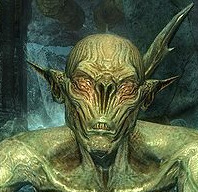
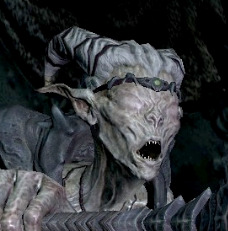
In concept art, particularly Adam Adamowicz's, we see more potential hairstyles. He draws it as wispy and messy, as well as containing braids and the ties we see in the shaman in the game. This art is largely what defines my own interpretation of their hair.
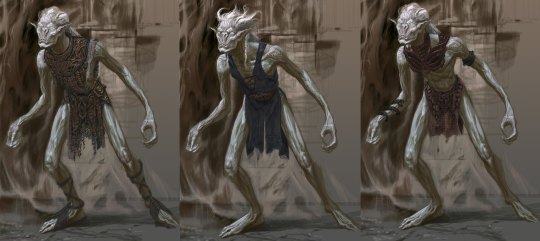

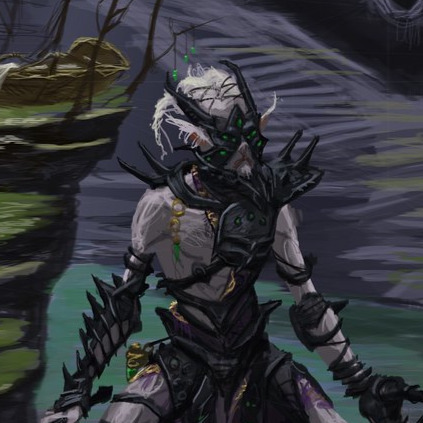
I picture the typical Falmer hair as wavy, thin, wispy, and looking frizzy. Given the high number of hairless Falmer we see, I imagine baldness is common, particularly among males, and sometimes among females. Their hair can be commonly styled into braids or knots to keep it under control.
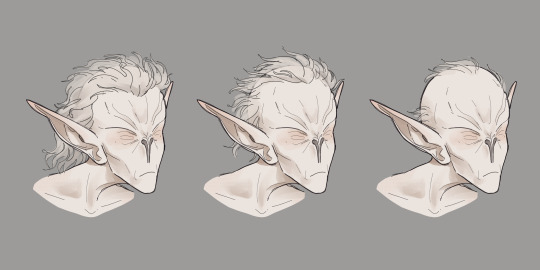
The ability to grow long, thick hair is less common, but those who can tend to style it in other unique ways. Especially among females, long hair is commonly styled into large dense locs (akin to a Polish plait) and held into shapes using ropes or leather ties.
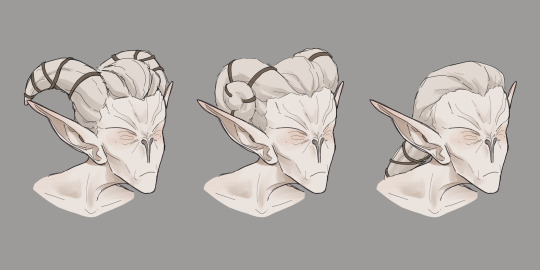
(While I think the intention with the way their hair is drawn and modelled in the game models and concept art was that it was braided and held up with those ties, before looking at it closely I always sorta interpreted it as too stiff to just be braided. As a result, I developed the locs headcanon and have become kinda attached to it even though I have 0 in game or lore support for it)
Materials
The material used in their clothing is obviously dependent on what is accessible to them, and given their unique situation that makes the materials they use and value unique as well. In Skyrim, we see that almost all of their armor (which is mostly what we see them wearing) and homes are made of chaurus chitin (and potentially shellbug chitin), so this is likely the most common resource available to them for non-combative coverings as well. Other materials from their arthropods companions could include their cocoons, unhatched eggs, etc.
Bones from other creatures (draugr, skeevers, trolls, adventurers, bandits, etc.) underground or from aboveground raids could also be used fairly often. These could also provide a source of leather or fur, albeit not a lot of it.
Falmer groups and subcultures inside or in close proximity to Dwemer ruins probably make regular use of the materials present in those ruins as well. With all the metal and machinery present in Dwemer ruins, metal probably makes regular appearances in their clothing (and general decorations) even if they can't manipulate it themselves. Falmer more separated from Dwemer ruins would make much lesser use of these materials, however. Additionally, We see implications of Falmer preparing, cooking, and potentially cultivating fungus in-game, but see nothing indicating they have any plants in their diet, and therefore it is unlikely they regularly make or use textiles or fabrics in their clothing, and if they do they likely come form Dwemer ruins or raided adventurers/bandits/settlements from the surface.
On that note, we know that there have supposedly been incidents of Falmer coming to the surface to attack its inhabitants and travelers, as well as instances of them killing bandits, adventurers, and researchers who venture below, so it's not far fetched to believe that they have access to some materials from the surface. This could give them some access to furs from surface animals, beads, glass, jewelry, textiles, metal objects, etc. they might not otherwise have access to. The rarity of these material among the Falmer would depend on the amount of access any given group of Falmer have to the surface, but among many of them these materials could be seen as more valuable for their rarity and the difficulty to gain them.
While gemstones and ore might be accessible from both natural deposits and underground ruins, unless they had some kind of auditory function or unique texture, they might not have much value to Falmer.
General Attire/Accessories
I like to imagine that the Snow Elves, and by extension the Falmer, have an innate cold resistance in the same way Nords do, and therefore don't require clothes for the purpose of warmth even in the chilly caves of Skyrim. Additionally, their blindness likely means that wouldn't dress for visual aesthetic either. My thoughts are that they are then left with the sense of sound and touch to communicate with each other, and their clothing and accessories could reflect that.
Falmer clothing, decoration, and society in general is very heavily based on touch and texture and little on appearances. They touch each other very often for both communication, movement, and just general day-to-day interactions, and their clothes isn’t very modest, but the tactile patterns and materials used can communicate certain things such as position in society, “wealth”/power, whether they are taken, single, pregnant, with a child, etc., their roles, their age, notable achievements/skills, who is who, etc. on both their clothes and buildings. The more noise one makes, the more attention they draw and the more they drown out other noises, and the more noise making things they can “afford” to have, so the amount of noise one makes in a Falmer settlement is a status symbol. Certain types of noises or noise makers are more coveted than others (chitin beads are common, while furs are less common, and materials only gained from raiding the surface are rare and coveted).
Some noise making accessories could include:
Dangling metal, bones, beads, chitin, etc. that hangs off of their clothing or ears and jingle/clank against each other (in my drawing I show them as pretty uniform in shape and size, but they would probably be much more irregular than I depicted them)
Bells (metal or other materials) that are affixed to or dangle off of their clothing or as earrings.
Hollow bracelets, anklets, necklaces, or other accessories that are filled with rocks or beads.
Rattles tied to the body (made of chitin, dried hollow chaurus eggs, dried chaurus cocoons, beads, etc.) with leather or rope.
Flute or whistle like tubes made of metal, chitin, or dried and treated tube-like fungus that makes a woodwind-esque noise when air passes through it in a certain way. They have been designed to make noise easily from even the slightest movements.
Dried grasses (more temporary) tied to the body that make a swishy noise. More permanently, a similar thing can be achieved with hair. The hair can be sourced from Falmer (either through just cutting hair or through taking it from fallen enemies) or killed humans/mer/draugr. That sort of thing can also act as a kind of trophy.
Necklaces with various materials dangling close together that jingle against each other.
Various materials can be tied into braids or the leather ties in their hair as well.
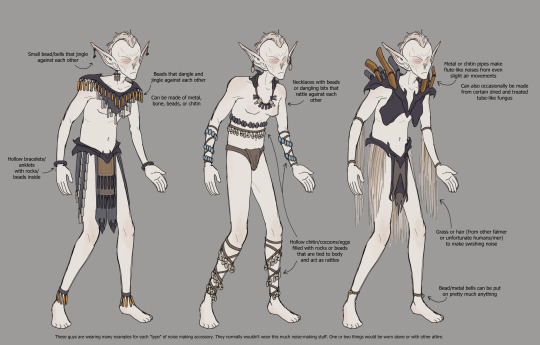
Some textural accessories could include:
Beads. Since they wouldn't have the ability to tell the color of the beads, the patterning of beadwork would be based on the roughness, material, size, or shape of the beads. (I'm sorry I suck as drawing beads)
Furs. This wouldn't be as common since the Falmer likely don't have too much interaction with furry mammals, but some they may have access to that are big enough to make clothing/accessories out of include skeevers or trolls (and potentially rarely animals from the surface). A potential meaning of wearing furs could be as hunting trophies, but it could have other meanings as well.
Chaurus chitin would like be the most common material in Falmer attire, and depending on the part of the chaurus body, the size of the chaurus, or the life stage of the chaurus it was sourced from it could have different textures. Some chitin parts could include large spikes and deep groves, while other parts could be smoother and less rough. The use of this chitin in clothing could take advantage of this contrast in textures. Additionally, chitin or shells from shell bugs might be a different texture from the chaurus chitin. (it's unclear to me whether shell bugs are exclusive to the caves around the Forgotten Vale or if we should consider them distributed throughout Skyrim's underground)
The placement of textured components on the body could have their own meaning to it alongside what accessories or textures are being used.
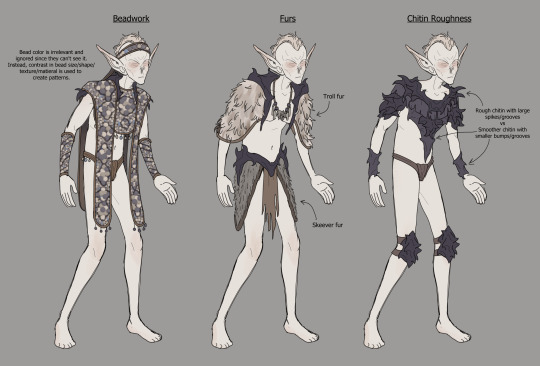
Specific Falmer Subcultures
While most Falmer settlements we see in Skyrim are just a small-ish collection of huts and chaurus corrals, there are two distinctive settlements that are larger, seemingly more organized, and I like to think have their own distinct subcultures worth mentioning: Blackreach and the Forgotten Vale. The unique scope and environment of these Falmer cities (as I like to think of them) could lend to unique clothing cultures as well.
The Falmer of Blackreach have access to a vast Dwemer settlement and have has the space to spread out throughout it more fully since it seems to be more in tact than other Dwemer ruins we see. These guys would likely have a clothing culture much more heavily based on what the can access from these Dwemer ruins (metal scraps, leftover fabrics, etc.)
The Falmer of the Forgotten Vale would also have access to unique resources, such as Vale deer, Vale sabre cats, and frost giants for fur and leather. Additionally, materials accessed from the Chantry of Auri-El such as textiles from clothing, bedding, tapestries, etc. could give them a greater access to fabrics than other Falmer groups. We don't see many close Dwemer settlements to the Vale, so they would have less Dwemeri influence in their clothing than other Falmer groups.
I like to think that the Falmer's evolution exclusively underground has made them poorly equipped to handle the outdoors during the day and has made them particularly susceptible to sunburn, necessitating the need for covering for those in the Forgotten Vale who have significant settlements outdoors. With greater access to textiles and leather, they could use them as coverings when outdoors.
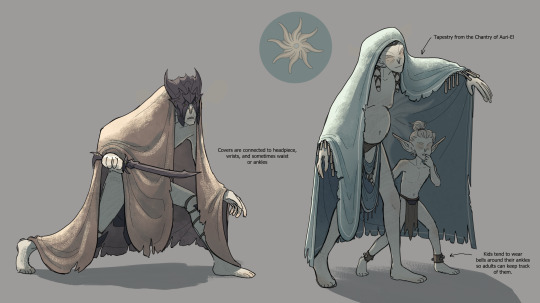
Armor
I actually have very few notes on armor, for two reasons. 1) I hate designing and drawing armor. It is the bane of my existence. 2) I really like the armor they have in game! I think they look awesome aesthetically, and I like how clearly they are made from chaurus chitin. Per usual, Adam Adamowicz's designs seem to have been the major inspiration for the Falmer armor, and he did a great jobs (even if it isn't the most functional looking armor ever).
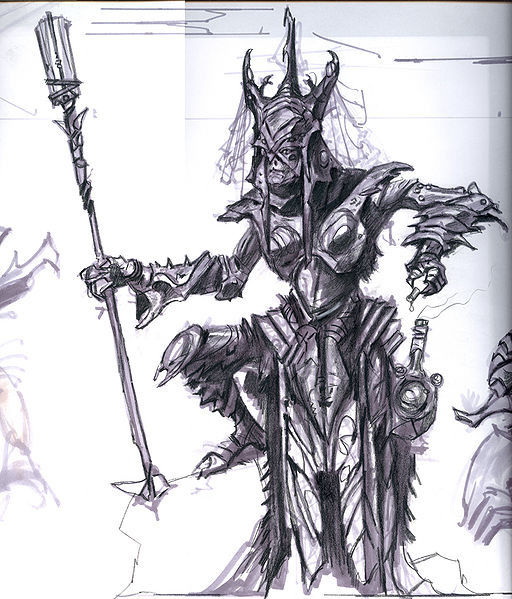
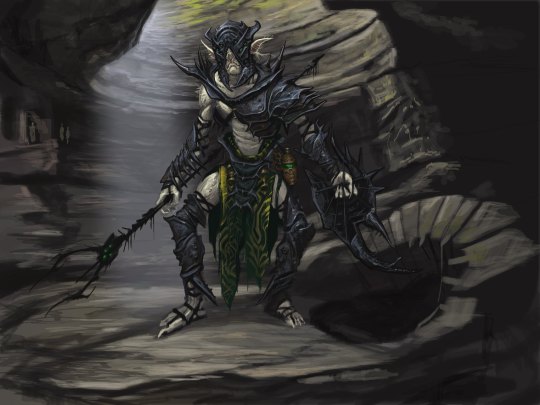
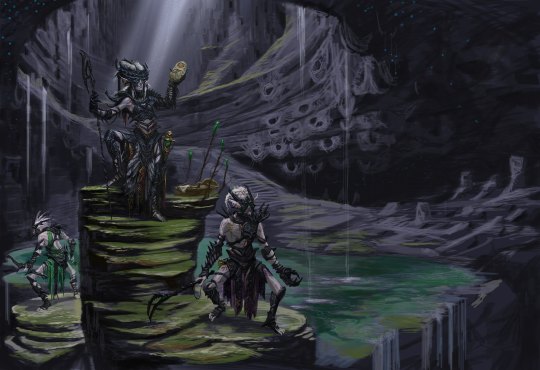
(off topic but I also just want to add that he draws them with little hairs and tufts on their ears and I love it. ok that is all)
I do have a few thoughts about armor though.
Even attire made of textiles make noise when someone moves in them, and I can imagine moving around in armor, especially armor made of hard, insect shells would make a lot of noise when someone moves around in it. When you're relying on sound to navigate your environment and pinpoint potential threats or targets, wearing something making a lot of noise would not be ideal. On the other hand, getting into a fight unarmored would be a problem.
So here's my solution: heavy armor (see below) would only be worm within the camps/settlements where noise was already high and space is more cramped (and therefore more risky in a fight) as a sort of guard in case they were attacked. Those guarding the settlements along the outside might still wear armor as well, but less of it. Those going out to scout or hunt (if they do hunt) would wear as little armor as possible, and try to wear it strategically so that it wouldn't rub against itself and make noise. This is why most Falmer we encounter in the game are wearing little except for loin cloths and kneepads.
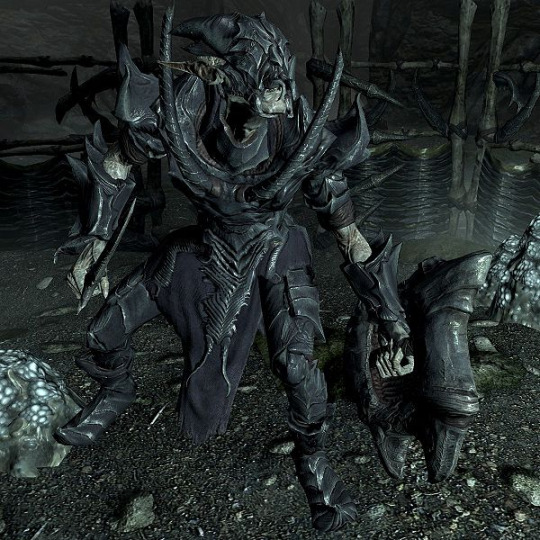
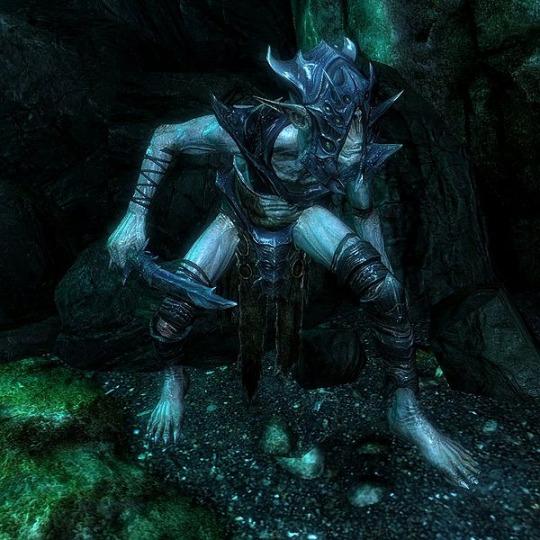
One more idea I have for armor is a specific armor piece. On the note of guarding or protecting a camp or settlement, I imagine the noises of it all (especially with the noise based headcanons I've laid out here) would make it hard to actually catch any potential threats when you can't see. A large slightly concave piece of armor worn behind the head could block out noises from behind the wearer, as well as a help focus sounds ahead of them.
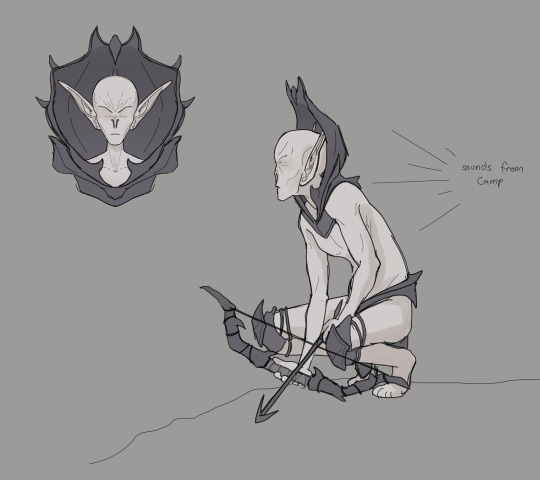
That is all! Thank you for reading! A lot of these concepts around the culture of sound I think could also be applied to their buildings and even a culture of music, but those are posts for another time.
All of the concept art I used was taken from here and all of the Skyrim screenshots are from UESP.
#skyrim#tes#the elder scrolls#falmer#skyrim headcanon#tes headcanons#headcanon#sorry this is long (but not really)#i just cant express my thoughts like a normal person. college conditioned me to format everything like an essay where i have to provide#sources and shit lol#also im kinda autistic about falmer#i appreciate those of you who read it all!#mine#adam's concept art makes me feel very validated in my echolocation headcanon because its very obvious he references bats in their face#which is another post idea i have for another day#my art
1K notes
·
View notes
Text
I see a post about how JK Rowling's goblins are antisemitic. I click on the person's blog. Their blog is filled with Holocaust inversion, MENA Jewish genocide denial, Hamas support, political "takes" from Twitter bitches with the red triangle in their usernames. I click out and block.
#its a little morbidly funny how consistent this is#like i can fairly accurately predict if someone is a raging antisemite based on the things they do choose to reblog about antisemitism s#which are always surface level criticisms of tropes in media#which while true sure are kind of an obvious distraction when there is a massive title wave of ~leftists~ reframing supporting antisemitic#terrorists as progressive praxis#🤷♀️🤷♀️#if youve posted about jk Rowling's goblins don't feel bad thwy are antisemitic#its just very obvious and stupid when someone is like HEY LOOK OVER HERE!! LOOK AT THAT!!! THAT KIDS STORY HAS BAD GUYS WITH BIG NOSES!!#DON'T LOOK BEHIND ME AT THE A CURSE UPON THE JEWS FLAG LOOK AT THE KIDS BOOK!!!#gingerswagfreckles#antisemitism#leftist antisemitism#jumblr
352 notes
·
View notes